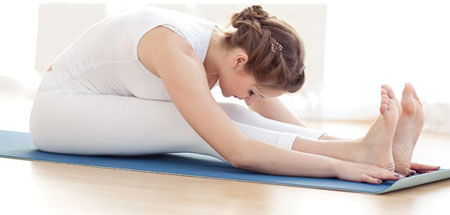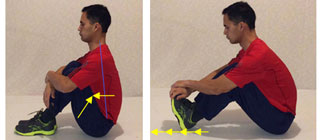The Better Way to Stretch Your Hamstrings to Avoid Back Problems
By Sherwin Nicholson | May 7, 2020
Stretch your hamstrings safely to improve your hip mobility
Current, common methods you have learned for stretching them is wrong. Please stop performing those traditional ‘reach for your toes’ stretches. They are both ineffective and dangerous.
A better and safer hamstring stretch is available here on this site. It is rarely taught anywhere else and is much safer on your back and your discs. Here’s why it matters.

Most of us can’t do this without great risk to our back
I am not about to tell you that stretching your hamstrings is a bad idea.
Not at all. It’s HOW you have been taught that’s bad.
And it’s very rare you’ve ever seen anyone (even professionals) hamstring stretch the right way as taught below, which is the safer way.
First impressions can be wrong
Take a look at the image above.
You can see someone who is doing a full stretch. Most us understand that this level of flexibility is rare and even unnecessary. Perhaps, it is only of importance for extreme practitioners of specialized sports or fitness activities.
But for the rest of us, we do NOT need to get to this level of flexibility to be pain-free.
What we should be aware, is that tight, short and even weak hamstrings are related to an increased risk of injury. What we don’t know is how flexible we need to be to reduce our risk of injury or even prevent it.
There is a comfortable zone or range in which the length of our hamstrings and also the flexibility of our hip flexors are desirable and provide adequate support for our lumbar spine.
Over time, with age, lack of use, genetics, injury, poor overall physical conditioning, etc., our flexibility and muscle length decreases. Your pelvic mobility becomes worse because your hamstrings attach from the pelvis to the femur.
Reduced pelvic, mobility leads to increased lumbar mobility such as bending and flexing. Excessive bending of the lumbar spine reduces the safe, natural lumbar curve, increasing the risk of disc wear and harm.
Most wear and tear on the discs are ‘silent’ and are not evident until significant damage and muscular tightness have developed. It is important to be proactive in maintaining flexibility before any signs of pain occur.
The Challenge and Where to Begin
The majority of stretches recommended are either very uncomfortable to perform, intimidating, risky to the lumbar spine or simply very unappealing to perform. As mentioned earlier, the above illustration is very advanced and even intimidating. It is not necessary to have a high level of flexibility for relief. For some with lower back injury, it may appear risky even to perform.
If you were asked to perform even a partial version of this stretch, without injuring your lower back, how would you do it? For most of us, it would be first, sitting down, upright, with legs together and extended, then lean forward and grab your feet or shins and pull. Please avoid this dangerous technique at all costs.
You may try to make the stretch easier by simply relaxing and allowing yourself to lean forward, using only your body weight.
Unfortunately, both methods are still very damaging to the lumbar discs (L1 to L5-S1), especially the L5-S1 disc due to the very high torque that is generated and resulting extreme pressure on the lower discs.
What To Do Next?
To determine what to do next, here are some questions about the above stretch.
1. How is it done?
The illustration may demonstrate a full stretch, but it only illustrates the final position. What is more important is the beginning. How you do the stretch is more important than any other part of the movement.
2. What is stretched?
In addition to loose and flexible hamstrings, you also need relaxed and flexible hip muscles and flexors. Relaxed and healthy lumbar muscles also help.
3. Why is it possible?
The person in the illustration can perform this full stretch with ease because she is already sufficiently flexible.
She is no longer trying to become flexible. For this person, she is merely trying to maintain her flexibility and has little to no discomfort. Her pelvic flexibility is key to her hamstring extension. There is no risk of disc injury for HER as there is no strain. As she is already ‘riding her bike,’ most of us are still ‘using our training wheels.’ The rest of us are risking injury.
4. Who can do it?
If you have genetic, structural or existent damage to the lumbar spine, then you must take into consideration your limits for any stretch. However, these conditions also limit your muscular fitness and will also impact their overall conditioning and increase your risk of harm.
5. Time to achieve it?
The amount of time required varies both with effort and whether there is already present discomfort or injury. Your range can be from weeks to years if the discomfort is severe.
A Better, Safer Stretch
The key to relieving lower back pain is through the following areas in the order as shown.
- Lumbar Stability (Curve)
- Hip Stability
- Hip Mobility
- Hip Flexibility
- Hamstring Isolation
- Hamstring Extension

To learn more, see the Correct Stretch Technique. This method is important when you add lunges to help protect your you.
To perform the Actual Stretch, follow the Tight Hamstrings method.
This approach is fully explained and illustrated. It is safer and easier to do. It does not require the full extension to achieve relief. It helps the user to become proactive in their stretch and protective of their spine. It supports all six areas above.
This technique becomes easier to perform with time and requires less time to execute as the user becomes more flexible. It not only provides flexibility, but it also makes the hips more flexible, addresses tight hips, hip pain, and tight lower back muscles.
To help you with pain and tightness:
Tight Hamstrings and Lower Back Pain
To learn more about your ‘hips and hams ‘
The best program to conquer your tight hams
References:
- Treat Your Own Back – 2011. Robin McKenzie. Gordon Soules Publishers. 9th Edition. www.gordonsoules.com
- http://www.ncbi.nlm.nih.gov/pubmed
- www.backcarecanada.ca
